OCZ's Vertex 2 Pro Preview: The Fastest MLC SSD We've Ever Tested
by Anand Lal Shimpi on December 31, 2009 12:00 AM EST- Posted in
- Storage
PCMark Vantage - A New Leader
The Vertex 2 Pro’s dominance doesn’t stop in the synthetic tests - we have a new winner in PCMark Vantage.
While I don’t like Vantage much as a CPU benchmark, it is one of the best real world indicators of SSD performance. Far better than a lot of the synthetic tests that are used by most. Performance in Vantage isn’t all that matters, but as a part of a suite it’s very important.
Luckily for OCZ and SandForce, the Vertex 2 Pro doesn’t disappoint here either. As a testament to how much they have their act together, I didn’t have to tell SandForce what their Vantage scores were - they already use it as a part of their internal test suite. This is in stark contrast to other newcomers to the SSD market that were surprised when I told them that their drives don’t perform well in the real world.
The Vertex 2 Pro is 6% faster than the X25-M G2 in the overall PCMark Vantage test and 12% faster in the HDD specific suite. It’s at the borderline for what’s noticeable in the real world for most users but the advantage is there.

The memories suite includes a test involving importing pictures into Windows Photo Gallery and editing them, a fairly benign task that easily falls into the category of being very influenced by disk performance.
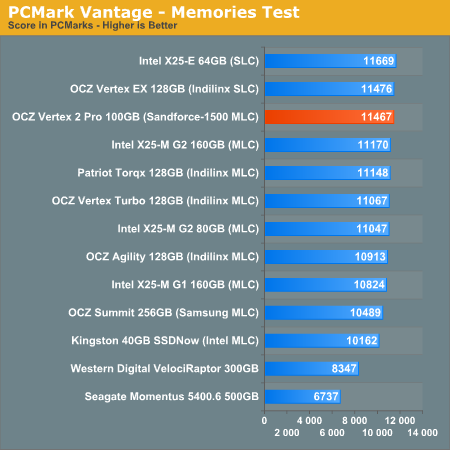
The TV and Movies tests focus on on video transcoding which is mostly CPU bound, but one of the tests involves Windows Media Center which tends to be disk bound.
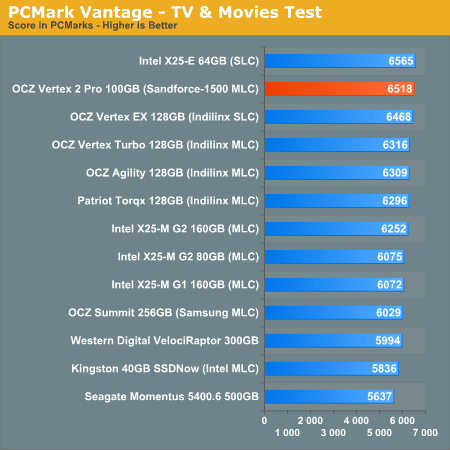
The gaming tests are very well suited to SSDs since they spend a good portion of their time focusing on reading textures and loading level data. All of the SSDs dominate here, but as you'll see later on in my gaming tests the benefits of an SSD really vary depending on the game. Take these results as a best case scenario of what can happen, not the norm.
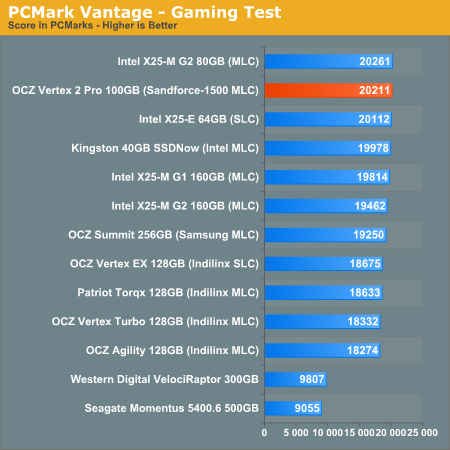
In the Music suite the main test is a multitasking scenario: the test simulates surfing the web in IE7, transcoding an audio file and adding music to Windows Media Player (the most disk intensive portion of the test).
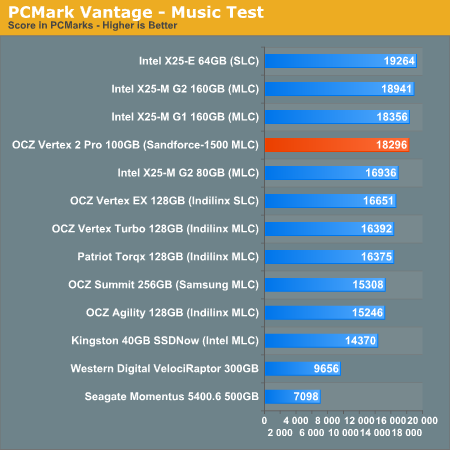
The Communications suite is made up of two tests, both involving light multitasking. The first test simulates data encryption/decryption while running message rules in Windows Mail. The second test simulates web surfing (including opening/closing tabs) in IE7, data decryption and running Windows Defender.
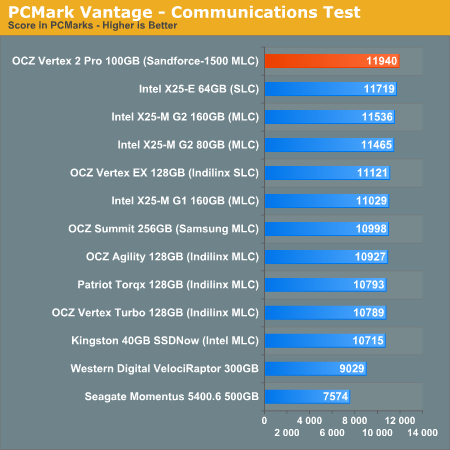
I love PCMark's Productivity test; in this test there are four tasks going on at once, searching through Windows contacts, searching through Windows Mail, browsing multiple webpages in IE7 and loading applications. This is as real world of a scenario as you get and it happens to be representative of one of the most frustrating HDD usage models - trying to do multiple things at once. There's nothing more annoying than trying to launch a simple application while you're doing other things in the background and have the load take forever.

The final PCMark Vantage suite is HDD specific and this is where you'll see the biggest differences between the drives:
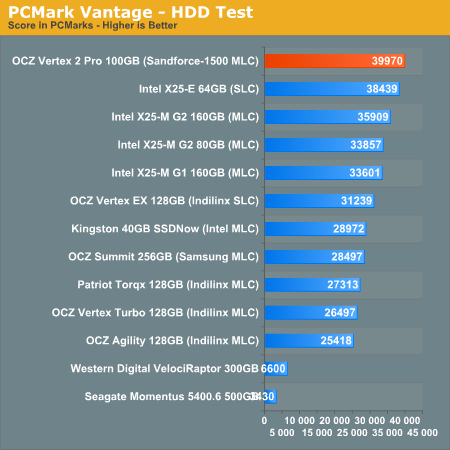










100 Comments
View All Comments
Howard - Friday, January 1, 2010 - link
Did you REALLY mean 90 millifarads (huge) or 90 uF, which is much more reasonable?korbendallas - Saturday, January 2, 2010 - link
Yep, it's 0.09F 5.5V Supercapacitor.http://www.cap-xx.com/images/HZ202HiRes.jpg">http://www.cap-xx.com/images/HZ202HiRes.jpg
iwodo - Friday, January 1, 2010 - link
If, all things being equal, it just shows that the current SSD drives performance aren't really limited by Flash itself but the controller.So may be with a Die Shrink we could get even more Random RW performance?
And i suspect these SSD aren't even using ONFI 2.1 chips either, so 600MB/s Seq Read is very feasible. Except SATA 3.0 is holding it all up.
How far are we from using PCI-Express based SSD? I am sure booting problem could be easily solved with UEFI,
ProDigit - Friday, January 1, 2010 - link
One of the factors would be if this drive has a processor that does real life compression of files on the SSD,that would mean that it would use more power on notebooks.Sure it's performance is top, as well as it's length in time that it works, but how much power does it use?
If it still is close to an HD it might be an interesting drive. But if it is more, it'd be interesting to see how much more!
I'm not interested in equipping a netbook or notebook/laptop with a SSD that uses more than 5W TDP.
chizow - Friday, January 1, 2010 - link
I've always noticed the many similarities between SSD controller technology and RAID technology with the multiple channel modules determining reads/write speeds along with write differences between MLC and SLC. The differences in SandForce's controller seems to take this analogy a step further with what is essentially RAID 5 compared to previous MLC SSDs.It seems like these drives use a lot of controller/processor power for redundancy/error checking code, which is very similar to a RAID 5 array. This allows them to do away with DRAM and gives them the flexibility to use cheaper NAND Flash, but at the expense of additional Flash capacity to store the parity/ECC data. I guess that begs the question, is 64MB of DRAM and the difference in NAND quality used more expensive than 30% more NAND Flash? Right now I'd say probably not until cheaper NAND becomes available, but if so it may make their technology more viable to widespread desktop adoption when that
Last thing I'll say is I think its a bit scary how much impact Anand's SSD articles have on this emerging market. He's like the Paul Muad'dib of SSDs and is able to kill a controller-maker with a single word lol. Seriously, after he exposed the stuttering and random read/write problems on Jmicron controllers back when OCZ first started using them, the mere mention of their name combined with SSDs has been taboo. OCZ has clearly recovered since then, as their Vertex drives have been highly regarded. I expect SandForce-based controllers to be all the buzz now going forward, largely because of this article.
pong - Friday, January 1, 2010 - link
It seems to me that Anand may be misunderstanding the reason for the impressive write amplification. The example with Windows Vista install + Office 2007 install states that 25GB is written to the disk, but only 11GB is written to flash. I don't believe this implies compression. It just means that a lot of the data written to disk is shortlived because it lives in temporary files which are deleted soon after or because the data is overwritten with more recent information. The 11GB is what ends up being on the disk after installation whether it is an SSD or a normal hard-drive. If the controller has significantly more RAM than other SSD controllers it doesn't have to commit short-lived changes to flash as often. The controller may also have logic that enables it to detect hotspots, ie areas of the logical disk that is written to often to improve the efficiency of its caching scheme. This sort of stuff could probably be implemented mostly in an OS except the OS can't guarantee that the stuff in the cache will make it to the disk if the power is suddenly cut. The SSD controller can make this guarantee if it can store enough energy - say in a large capacitor - to commit everything it has cached to flash when power is removed.shawkie - Friday, January 1, 2010 - link
Unless I misread it the article seems be claiming that the device actually has no cache at all.bji - Friday, January 1, 2010 - link
I think the article said that the SSD has no RAM external to the controller chip, but that the controller chip itself likely has some number of megabytes of RAM, much of which is likely used for cache. It's not clear, but it's very, very hard to believe that the device could work without any kind of internal buffering; but that this device does it with less DRAM than other SSDs (i.e., the smaller amount of DRAM built into the controller chip versus a separate external tens-of-megabytes DRAM chip).gixxer - Friday, January 1, 2010 - link
I thought the vertex supported Trim thru windows 7, yet in the article Anand says this:"With the original Vertex all you got was a command line wiper tool to manually TRIM the drive. While Vertex 2 Pro supports Windows 7 TRIM, you also get a nifty little toolbox crafted by SandForce and OCZ:"
Does the Vertex drive support windows 7 trim or do you still have to use the manual tool?
MrHorizontal - Friday, January 1, 2010 - link
Very interesting controller, though they've seemed to have missed a couple of tricks...First why is an 'enterprise' controller like this not using SAS which is at 6GBps right now and we can see what effect a non-3GBps interface has on SSDs, and why when SATA 6GBps is being shipped in motherboards now, then in 2010, when these SandForce drives are going to be released will still be using 3GBps SATA...
Second, the 'RAID' features of this drive seem to be like RAID5 distributing parity hashes across the spare area which is also distributed across the drive. However, all controllers have multiple channels and why they don't use RAID6 (the one where a dedicated drive holds parity data, not the 2-stripe RAID5) whereby they use 1 or 2 SLC NAND Flash chips to hold the more important data, and use really cheap MLC NAND to hold the actual data in a redundant manner?